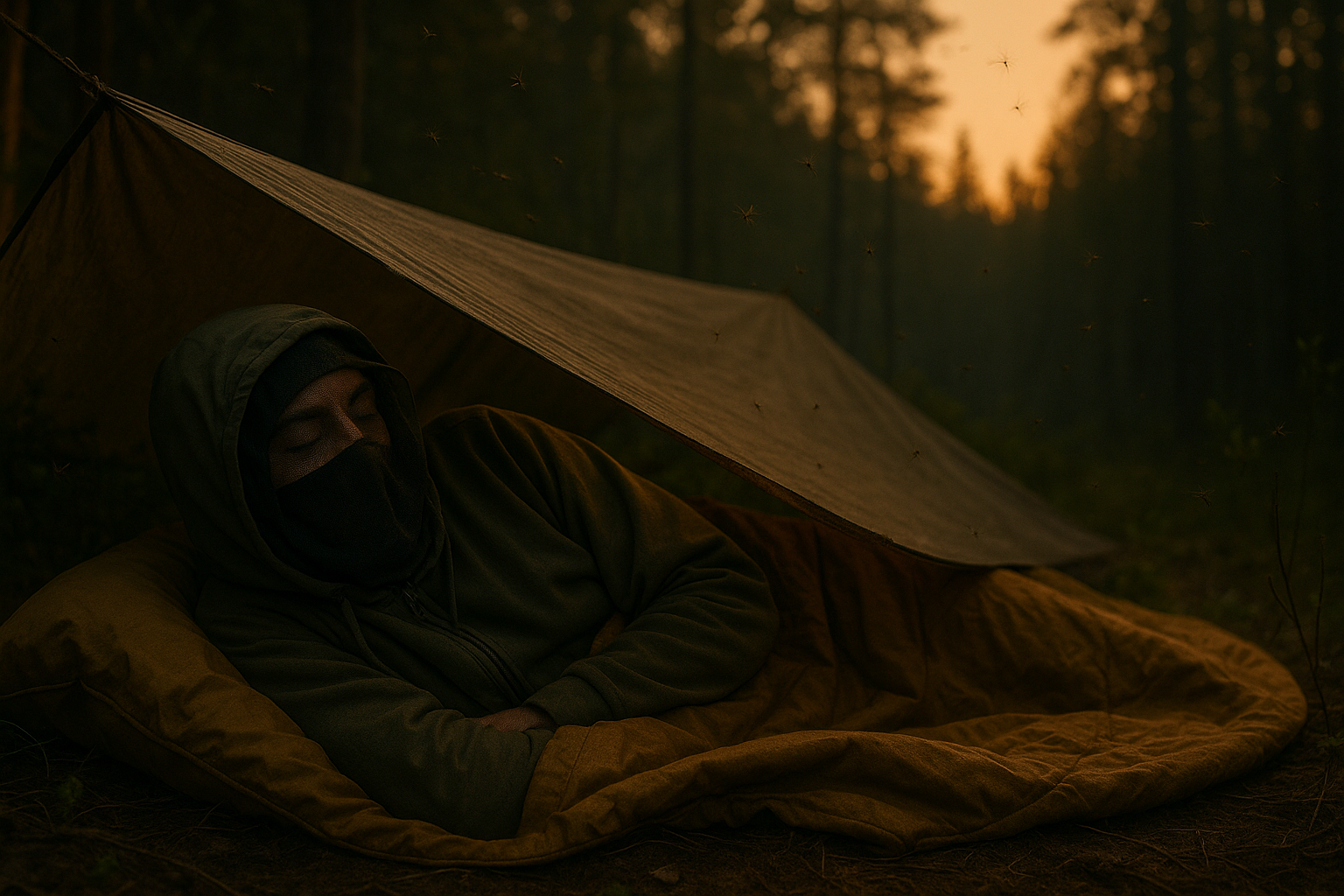You made it through the day.
Set up camp. Got your food down. Laid out your sleep gear.
Then the night hits — and with it, the mosquitoes, no-see-ums, biting flies, and crawlers that treat your skin like a midnight buffet.
Suddenly, sleep is impossible.
Your arms itch. Your ears buzz. You slap yourself more than your worst enemy would.
And in survival camping, poor sleep = poor judgment = real danger.
This guide is your tactical answer:
Lightweight, packable bug defense that actually works — even when you’re solo, off-grid, and can’t afford to carry extra bulk.
🦟 Why Bug Bites Are More Than Just Annoying
- Bites disrupt sleep → which weakens immune response, slows thinking, and shortens endurance.
- Scratching opens skin → risking infection when you’re far from help.
- Buzzing = psychological torture → that breaks morale during cold, wet, or dangerous conditions.
For survivalists, motorcyclists, and ultralight hikers — lightweight protection is your first line of defense against breakdown.
🔥 Your Lightweight Bug Defense Strategy (No Sprays, No Net Tents)
You don’t need to carry a 2lb bug shelter.
You don’t need DEET that melts your gear.
You need this 3-part field strategy:
1. Create a physical barrier.
2. Deploy heat-free, scent-smart repellents.
3. Use your gear to double as insect armor.
Let’s break it down:
🥼 1. Head-to-Toe Clothing Defense (The Right Layers Make You Untouchable)
✅ Merino or Synthetic Base Layer with Tight Weave
- Worn head-to-toe at dusk
- Lightweight but blocks most mosquito stingers
- Moisture-wicking = keeps sweat off skin = fewer bugs attracted
Best piece:
- Thin merino hoodie with thumb holes and a ponytail-compatible hood
- Worn with long pants tucked into socks
✅ Buff or Neck Gaiter for Face + Ears
- Bugs love to swarm ears and neck
- Lightweight buff covers both without smothering you
- Can be soaked in lemon eucalyptus oil for double defense
✅ Glove Liners or Sock Gloves
- Bugs bite fingers at night when you sleep with hands exposed
- Lightweight glove liners or even socks over hands prevent this
🧠 Pro Tip: Tuck pant cuffs into socks and shirt cuffs into gloves before bed. Bugs can’t crawl into seams.
🧢 2. Field-Grade Head Net — Without the Full Tent Setup
✅ Ultralight Mosquito Head Net (~0.6 oz)
- Packs into a pouch the size of a ping pong ball
- Slip it over your hat or hood while sleeping
- Prevents bites on lips, eyes, eyelids, and nose
Why it works:
- Most bites happen on the face overnight — this blocks 90% of them
- Head nets work even in bivy sacks or open tarps without tents
🧠 Pro Tip: Layer your hood over the net so it doesn’t flap around. Tuck neck area under your shirt collar.
🛏️ 3. Bug-Proof Sleep Zone Without Carrying a Tent
✅ Use a Bug Bivy (7 oz – 12 oz range)
- Example: Sea to Summit Nano Mosquito Pyramid or Outdoor Research Bug Bivy
- Sets up with trekking poles or just your headlamp + cord
- Let’s you sleep bug-free under a tarp, in the open, or under a tree canopy
Why it’s better than a net tent:
- Packs small
- 50–70% lighter
- Still allows full airflow for hot nights
- Works inside a sleeping bag or quilt system
🧴 4. Non-Toxic, Lightweight Bug Repellents That Don’t Smell Like Chemicals
DEET may work — but it smells like weaponized plastic and melts gear. In ultralight camping, smarter options exist.
✅ Lemon Eucalyptus Oil (or Picardin Wipes)
- Lemon Eucalyptus Spray: 2 oz travel bottle = 6+ nights of use
- Picardin Wipes: UL campers’ secret weapon — 1 wipe = 12-hour coverage
Where to apply:
- Ankles
- Wrists
- Behind ears
- Shirt cuffs and pant openings
Bonus Field Trick:
Soak a strip of cloth with repellent and tie around ankle or neck. Acts like a “scent force field” against crawlers and midges.
🧤 5. Gear-as-Bug-Armor Tactics
When you don’t have the right tools — you reimagine the ones you do.
🥣 Heat Food Pouches — Then Sleep with Them
- Warm food pouches (like vacuum-sealed stews or rice) inside your jacket as chest warmers
- Creates minor radiant heat zones that pull bugs away from extremities
Warm zones draw bugs — so bait them where you’re covered.
🎒 Use Dry Bags or UL Backpacks as Leg Shields
- Lay a dry bag over your legs or feet if you’re sleeping without a bivy
- Packs double as shin/ankle shields when lying under a tarp
- Bugs hate slippery nylon
🧤 6. Use Your Gear as Bug Armor
When you’re packing light, everything you carry must serve double duty — including your sleeping gear and clothing.
🥣 Warm Food Pouches = Insect Distraction Tools
Before you eat, warm up vacuum-sealed or boil-in-bag meals (even by tucking them under your jacket if you don’t have fire). After eating, reuse the warmed pouch by placing it under your jacket or sleeping bag in a less sensitive zone (like your chest or thighs). Bugs will often gravitate toward the heat — away from your face and exposed skin.
🎒 Backpack or Dry Bags as Leg Shields
Lay your dry bag, stuff sack, or backpack directly over your legs or feet while sleeping under a tarp. Even a small surface shield drastically reduces surface bites from mosquitoes and crawling insects.
If you’re in a bivy sack or under a poncho shelter, positioning gear near your head and shoulders creates a barrier that bugs struggle to bypass.
🧠 Tuck the bottom of your sleeping bag into your pack’s opening if you don’t have a bivy — it stops crawlers from invading the footbox.
🧪 7. Bug-Repelling Wipes and Oils That Don’t Weigh You Down
Sprays are often bulky, messy, and banned on ultralight gear lists. But Picaridin wipes and lemon eucalyptus oil are game-changers:
✅ Picaridin Wipes (0.1 oz per wipe)
- One wipe covers arms, ankles, and neck for 10+ hours
- Non-greasy, odorless, and doesn’t damage gear like DEET
✅ Lemon Eucalyptus Oil (1 oz dropper bottle)
- Natural scent that bugs hate
- Dab on temples, behind ears, wrists, and ankle cuffs
- Soak a bandana or buff in it for passive area protection
🧠 A few drops of eucalyptus oil on your buff keeps bugs out and clears sinuses while you sleep.
🛠 8. Bug-Proof Sleep Positioning (Even Without a Net)
No bug net? You can still protect yourself by how you sleep and where you camp.
✅ Sleep with Your Back to the Wind
Even light breeze (2–3 mph) drastically reduces mosquito landings.
Set up camp to face into natural airflow, not behind brush or terrain that blocks air.
✅ Face Down or Hooded
Tighten your hoodie or sleeping bag hood to cover your ears and jaw — then turn your face into your sleeve or arm.
This blocks buzzing and stops eyelid or lip bites.
✅ Use Your Buff as a Face Mask
Pull your buff over your nose and chin to reduce exposure and filter exhaled CO₂ — which draws bugs.
🌿 9. Build a Natural Insect Perimeter Without Chemicals
If you’re out of repellent and exposed, you can still slow the swarm:
✅ Citronella + Sage + Dry Pine Needles
Burn crushed sage or pine needles near your shelter.
Even smoldering small twigs releases compounds bugs hate.
✅ Mud Smear Method (Last Resort)
Mix mud with wood ash and smear a thin layer on exposed skin.
It blocks scent and stops direct contact. Only use in desperate scenarios (not daily — clogs pores).
🧠 Old field trick from jungle survival — crude but effective in high-bug environments.
💼 10. Pack Smart: The 6-Ounce Anti-Bug Kit That Could Save Your Sanity
You don’t need a full-size bug shelter. Just carry these:
| Item | Weight |
|---|---|
| Mosquito head net | ~0.6 oz |
| Buff or neck gaiter | ~1.5 oz |
| Picaridin wipes (4–5) | ~0.5 oz total |
| Lemon eucalyptus oil (1 oz) | ~1 oz |
| Merino long-sleeve hoodie | ~2 oz (base layer) |
| Mini dry bag (leg shield use) | Already in pack |
Total: ~6 oz
Impact: Up to 90% reduction in bites, stress, and sleep disruption — for less weight than your fire starter.
💡 Bonus Camp Setup Tips
- Don’t camp near stagnant water — even 30 feet makes a huge difference
- Pick breezy, dry terrain — 2 mph of airflow = natural protection
- Clear rotting leaves or fruit near your sleep area — they attract midges and ants
🧪 Optional Add-Ons for Extreme Bug Zones
If you’re camping in brutal bug areas like Alaska, the Everglades, or the Sierra foothills mid-summer:
- Permethrin-treated clothes (socks, gaiters, shirt)
- Mini battery-powered Thermacell coil (clip-on)
- Mosquito incense sticks (citronella or lemongrass)
Still stays under 1 lb of total bug gear weight.
🌄 Conclusion: Don’t Let Bugs Beat Your Brain
Bug bites don’t just make you itch.
They wreck sleep, impair thinking, and wear down your survival edge — fast.
With the right 6–10 oz of smart bug protection, you regain focus, comfort, and decision-making clarity when it matters most.
In the wild, your gear isn’t just protection — it’s neural armor.

